Moved from here.
Hello my name is Rob and I live in Bluffton, South Carolina. I just found this blog and am hoping I can get recommendations on the issue I am having with my pool. I own a 10k gallon fiberglass pool and hot tub. It is only five years old. My pool and hot tub, especially the hot tub, is suffering from severe calcium buildup on the sides and particularly on the flat surfaces. I do not know exactly what type of calcium buildup it is, but I am assuming it is silicate given how difficult it is to remove. I have been reading with interest Pat's (Texas Splash) posts about his pool issue over the years. From the pictures he has posted, my problem seems to be the same. I have attached some pictures below of what I am dealing with in the hot tub.
The first two pics show my hot tub after sanding the first two steps. You can see the difference between what was sanded and the lower step and main seating area that are still thickly coated with the calcium buildup. Adding to the frustration in trying to remove the buildup is that all the flat surfaces are textured. Even with the smooth walls it is impossible to get all the buildup off. After sanding, I then used two different brand names of rubbing compound (Meguiars Heavy Duty Oxidation Remover N49, and 3M Perfect-It EX 306060), but the hazing was still visible on the smooth surfaces, and it did nothing for the buildup in the pitts of the textured surfaces. I also tried to use CLR, Sodium Bisulfate, and Muriatic acid, hoping that one of these might just dissolve the buildup. But nothing seems to work, the way I would like it to work, or I am just not doing it right. When I used the muriatic acid, I would apply a few drops of the full strength acid to a small area then scrub with a stiff brush trying to get into the pitts on the textured surface. When scrubbing with the acid I did get up some type of flaking, but I do not know if the flaking is the buildup or possibly some of the gelcoat that came off. I have included a pic of the flakings that came off.
I would appreciate any help or advice that anyone can give me.
Thanks
Hello my name is Rob and I live in Bluffton, South Carolina. I just found this blog and am hoping I can get recommendations on the issue I am having with my pool. I own a 10k gallon fiberglass pool and hot tub. It is only five years old. My pool and hot tub, especially the hot tub, is suffering from severe calcium buildup on the sides and particularly on the flat surfaces. I do not know exactly what type of calcium buildup it is, but I am assuming it is silicate given how difficult it is to remove. I have been reading with interest Pat's (Texas Splash) posts about his pool issue over the years. From the pictures he has posted, my problem seems to be the same. I have attached some pictures below of what I am dealing with in the hot tub.
The first two pics show my hot tub after sanding the first two steps. You can see the difference between what was sanded and the lower step and main seating area that are still thickly coated with the calcium buildup. Adding to the frustration in trying to remove the buildup is that all the flat surfaces are textured. Even with the smooth walls it is impossible to get all the buildup off. After sanding, I then used two different brand names of rubbing compound (Meguiars Heavy Duty Oxidation Remover N49, and 3M Perfect-It EX 306060), but the hazing was still visible on the smooth surfaces, and it did nothing for the buildup in the pitts of the textured surfaces. I also tried to use CLR, Sodium Bisulfate, and Muriatic acid, hoping that one of these might just dissolve the buildup. But nothing seems to work, the way I would like it to work, or I am just not doing it right. When I used the muriatic acid, I would apply a few drops of the full strength acid to a small area then scrub with a stiff brush trying to get into the pitts on the textured surface. When scrubbing with the acid I did get up some type of flaking, but I do not know if the flaking is the buildup or possibly some of the gelcoat that came off. I have included a pic of the flakings that came off.
I would appreciate any help or advice that anyone can give me.
Thanks
Attachments
Last edited by a moderator:


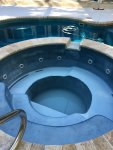
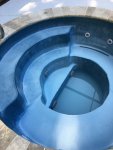
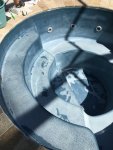
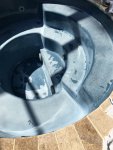
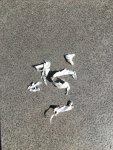
 Well, all I can say is I sympathize with you on this one. By all accounts from my own experience and the current science provided, we can only assume it's an unfortunate, unpreventable change of the gelcoat that could not be foreseen even if the water chemistry was maintained perfect the whole time. Before I forget, please post a full set of water test results with your TF-100 or Taylor K-2006C. The manufactures are virtually no help and will blame the issue on the owner anyways. I doubt the flakes coming off are any sort of calcium, otherwise it would've fizzled when acid was applied. That was the first test I was asked to do by Viking - lower water level to expose the top step and pour acid on it. No fizzle - not calcium. Viking referred to it as a form of oxidation, but would not accept any responsibility unless we had consistent (ridiculous/inaccurate) pool store testing.
Well, all I can say is I sympathize with you on this one. By all accounts from my own experience and the current science provided, we can only assume it's an unfortunate, unpreventable change of the gelcoat that could not be foreseen even if the water chemistry was maintained perfect the whole time. Before I forget, please post a full set of water test results with your TF-100 or Taylor K-2006C. The manufactures are virtually no help and will blame the issue on the owner anyways. I doubt the flakes coming off are any sort of calcium, otherwise it would've fizzled when acid was applied. That was the first test I was asked to do by Viking - lower water level to expose the top step and pour acid on it. No fizzle - not calcium. Viking referred to it as a form of oxidation, but would not accept any responsibility unless we had consistent (ridiculous/inaccurate) pool store testing. 
